Food Safety Knowledge, Attitude, and Practice Among Jordan Students
VerifiedAdded on 2023/04/25
|86
|26260
|323
Thesis and Dissertation
AI Summary
This thesis investigates the food safety knowledge, attitudes, and practices (KAP) among students at a university in Jordan. It highlights the global concern of foodborne illnesses, emphasizing the significance of proper food handling and hygiene. The study addresses the gap in research regarding university students' awareness and practices related to food safety, particularly in the Middle Eastern context where foodborne disease incidence is high. The research aims to assess students' understanding of safe food handling procedures, their attitudes towards food safety, and their actual practices in food preparation and consumption. By identifying knowledge gaps and influencing factors, the thesis seeks to inform future educational interventions and improve food safety practices among university students, contributing to the reduction of foodborne illnesses within the community. Desklib provides access to this thesis and other solved assignments for students.
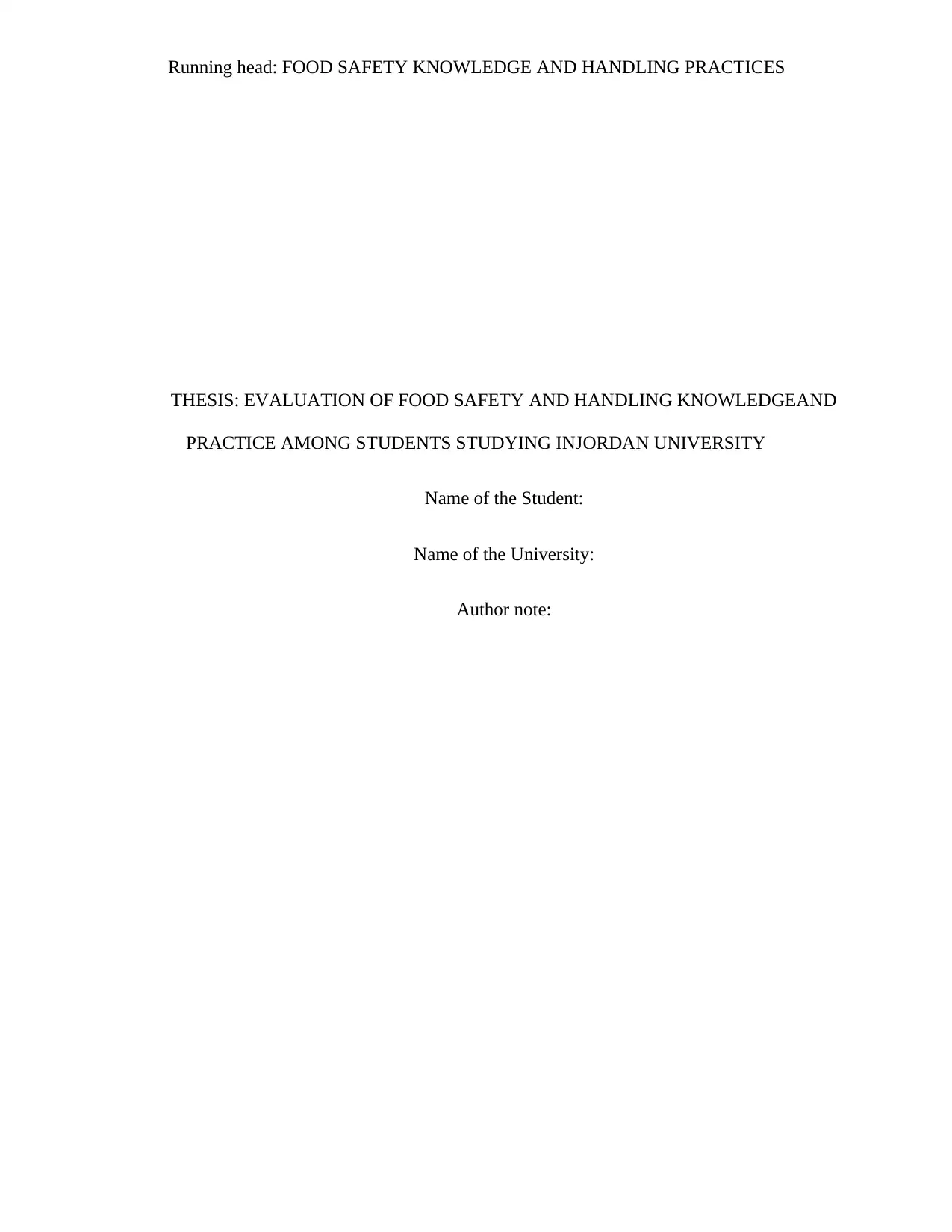
Running head: FOOD SAFETY KNOWLEDGE AND HANDLING PRACTICES
THESIS: EVALUATION OF FOOD SAFETY AND HANDLING KNOWLEDGEAND
PRACTICE AMONG STUDENTS STUDYING INJORDAN UNIVERSITY
Name of the Student:
Name of the University:
Author note:
THESIS: EVALUATION OF FOOD SAFETY AND HANDLING KNOWLEDGEAND
PRACTICE AMONG STUDENTS STUDYING INJORDAN UNIVERSITY
Name of the Student:
Name of the University:
Author note:
Paraphrase This Document
Need a fresh take? Get an instant paraphrase of this document with our AI Paraphraser
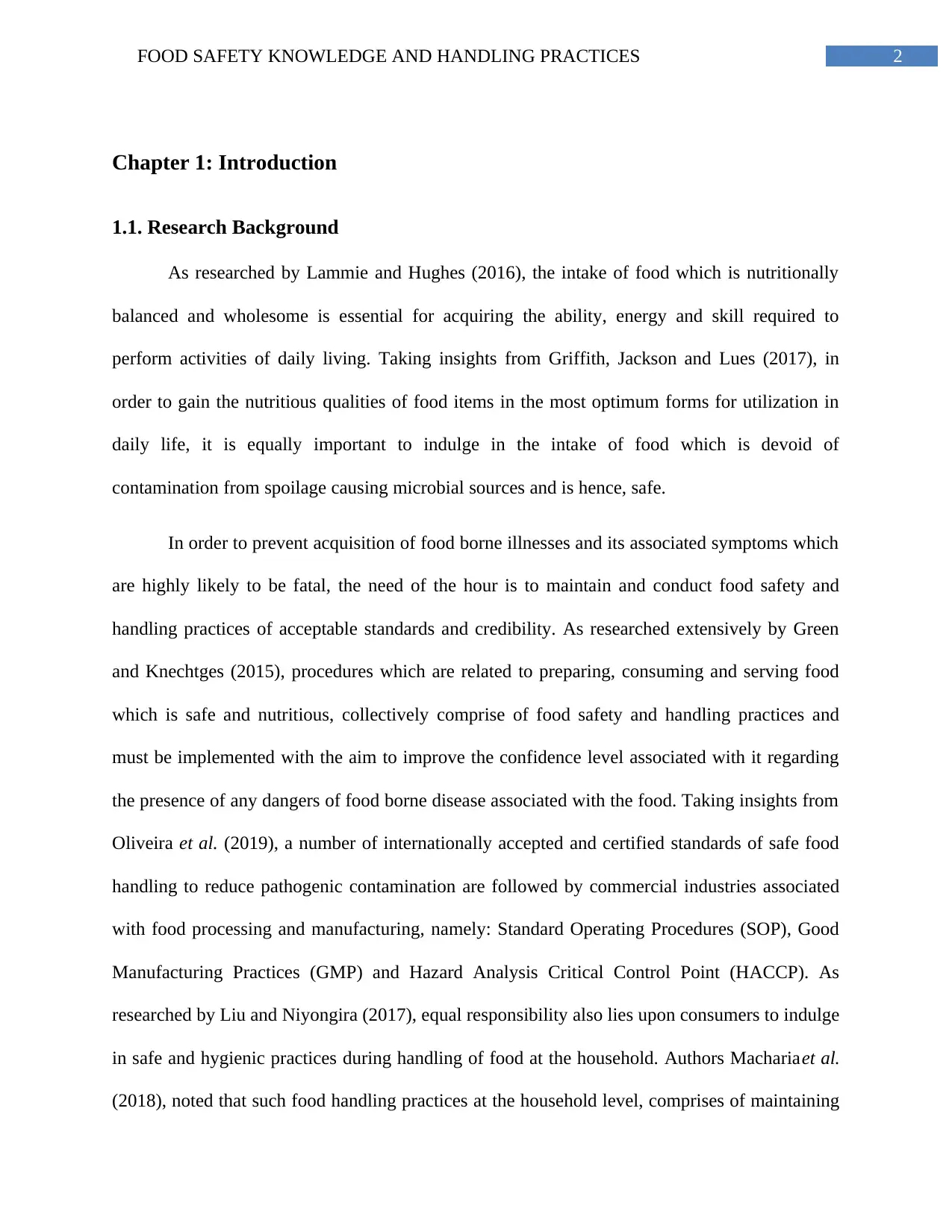
2FOOD SAFETY KNOWLEDGE AND HANDLING PRACTICES
Chapter 1: Introduction
1.1. Research Background
As researched by Lammie and Hughes (2016), the intake of food which is nutritionally
balanced and wholesome is essential for acquiring the ability, energy and skill required to
perform activities of daily living. Taking insights from Griffith, Jackson and Lues (2017), in
order to gain the nutritious qualities of food items in the most optimum forms for utilization in
daily life, it is equally important to indulge in the intake of food which is devoid of
contamination from spoilage causing microbial sources and is hence, safe.
In order to prevent acquisition of food borne illnesses and its associated symptoms which
are highly likely to be fatal, the need of the hour is to maintain and conduct food safety and
handling practices of acceptable standards and credibility. As researched extensively by Green
and Knechtges (2015), procedures which are related to preparing, consuming and serving food
which is safe and nutritious, collectively comprise of food safety and handling practices and
must be implemented with the aim to improve the confidence level associated with it regarding
the presence of any dangers of food borne disease associated with the food. Taking insights from
Oliveira et al. (2019), a number of internationally accepted and certified standards of safe food
handling to reduce pathogenic contamination are followed by commercial industries associated
with food processing and manufacturing, namely: Standard Operating Procedures (SOP), Good
Manufacturing Practices (GMP) and Hazard Analysis Critical Control Point (HACCP). As
researched by Liu and Niyongira (2017), equal responsibility also lies upon consumers to indulge
in safe and hygienic practices during handling of food at the household. Authors Machariaet al.
(2018), noted that such food handling practices at the household level, comprises of maintaining
Chapter 1: Introduction
1.1. Research Background
As researched by Lammie and Hughes (2016), the intake of food which is nutritionally
balanced and wholesome is essential for acquiring the ability, energy and skill required to
perform activities of daily living. Taking insights from Griffith, Jackson and Lues (2017), in
order to gain the nutritious qualities of food items in the most optimum forms for utilization in
daily life, it is equally important to indulge in the intake of food which is devoid of
contamination from spoilage causing microbial sources and is hence, safe.
In order to prevent acquisition of food borne illnesses and its associated symptoms which
are highly likely to be fatal, the need of the hour is to maintain and conduct food safety and
handling practices of acceptable standards and credibility. As researched extensively by Green
and Knechtges (2015), procedures which are related to preparing, consuming and serving food
which is safe and nutritious, collectively comprise of food safety and handling practices and
must be implemented with the aim to improve the confidence level associated with it regarding
the presence of any dangers of food borne disease associated with the food. Taking insights from
Oliveira et al. (2019), a number of internationally accepted and certified standards of safe food
handling to reduce pathogenic contamination are followed by commercial industries associated
with food processing and manufacturing, namely: Standard Operating Procedures (SOP), Good
Manufacturing Practices (GMP) and Hazard Analysis Critical Control Point (HACCP). As
researched by Liu and Niyongira (2017), equal responsibility also lies upon consumers to indulge
in safe and hygienic practices during handling of food at the household. Authors Machariaet al.
(2018), noted that such food handling practices at the household level, comprises of maintaining
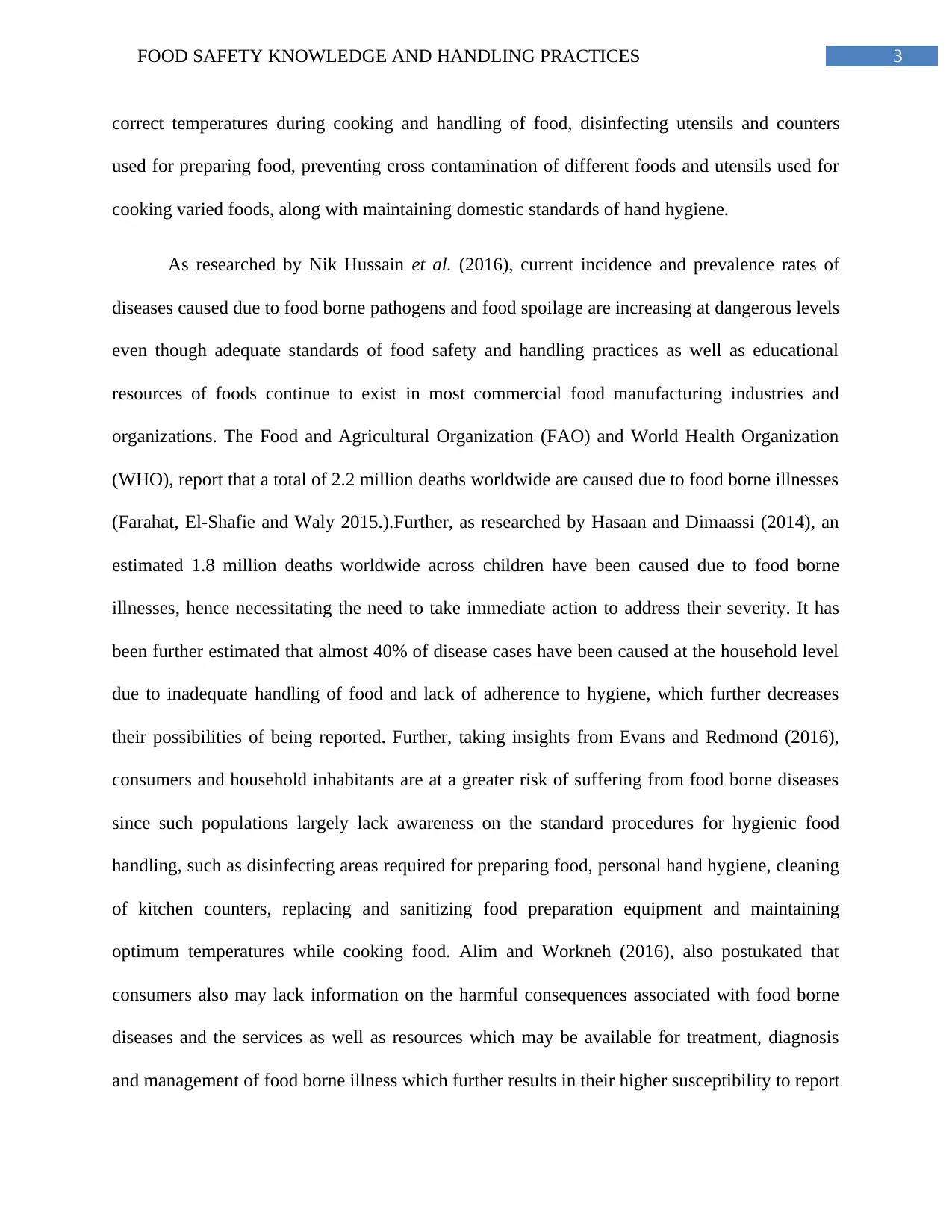
3FOOD SAFETY KNOWLEDGE AND HANDLING PRACTICES
correct temperatures during cooking and handling of food, disinfecting utensils and counters
used for preparing food, preventing cross contamination of different foods and utensils used for
cooking varied foods, along with maintaining domestic standards of hand hygiene.
As researched by Nik Hussain et al. (2016), current incidence and prevalence rates of
diseases caused due to food borne pathogens and food spoilage are increasing at dangerous levels
even though adequate standards of food safety and handling practices as well as educational
resources of foods continue to exist in most commercial food manufacturing industries and
organizations. The Food and Agricultural Organization (FAO) and World Health Organization
(WHO), report that a total of 2.2 million deaths worldwide are caused due to food borne illnesses
(Farahat, El-Shafie and Waly 2015.).Further, as researched by Hasaan and Dimaassi (2014), an
estimated 1.8 million deaths worldwide across children have been caused due to food borne
illnesses, hence necessitating the need to take immediate action to address their severity. It has
been further estimated that almost 40% of disease cases have been caused at the household level
due to inadequate handling of food and lack of adherence to hygiene, which further decreases
their possibilities of being reported. Further, taking insights from Evans and Redmond (2016),
consumers and household inhabitants are at a greater risk of suffering from food borne diseases
since such populations largely lack awareness on the standard procedures for hygienic food
handling, such as disinfecting areas required for preparing food, personal hand hygiene, cleaning
of kitchen counters, replacing and sanitizing food preparation equipment and maintaining
optimum temperatures while cooking food. Alim and Workneh (2016), also postukated that
consumers also may lack information on the harmful consequences associated with food borne
diseases and the services as well as resources which may be available for treatment, diagnosis
and management of food borne illness which further results in their higher susceptibility to report
correct temperatures during cooking and handling of food, disinfecting utensils and counters
used for preparing food, preventing cross contamination of different foods and utensils used for
cooking varied foods, along with maintaining domestic standards of hand hygiene.
As researched by Nik Hussain et al. (2016), current incidence and prevalence rates of
diseases caused due to food borne pathogens and food spoilage are increasing at dangerous levels
even though adequate standards of food safety and handling practices as well as educational
resources of foods continue to exist in most commercial food manufacturing industries and
organizations. The Food and Agricultural Organization (FAO) and World Health Organization
(WHO), report that a total of 2.2 million deaths worldwide are caused due to food borne illnesses
(Farahat, El-Shafie and Waly 2015.).Further, as researched by Hasaan and Dimaassi (2014), an
estimated 1.8 million deaths worldwide across children have been caused due to food borne
illnesses, hence necessitating the need to take immediate action to address their severity. It has
been further estimated that almost 40% of disease cases have been caused at the household level
due to inadequate handling of food and lack of adherence to hygiene, which further decreases
their possibilities of being reported. Further, taking insights from Evans and Redmond (2016),
consumers and household inhabitants are at a greater risk of suffering from food borne diseases
since such populations largely lack awareness on the standard procedures for hygienic food
handling, such as disinfecting areas required for preparing food, personal hand hygiene, cleaning
of kitchen counters, replacing and sanitizing food preparation equipment and maintaining
optimum temperatures while cooking food. Alim and Workneh (2016), also postukated that
consumers also may lack information on the harmful consequences associated with food borne
diseases and the services as well as resources which may be available for treatment, diagnosis
and management of food borne illness which further results in their higher susceptibility to report
⊘ This is a preview!⊘
Do you want full access?
Subscribe today to unlock all pages.

Trusted by 1+ million students worldwide
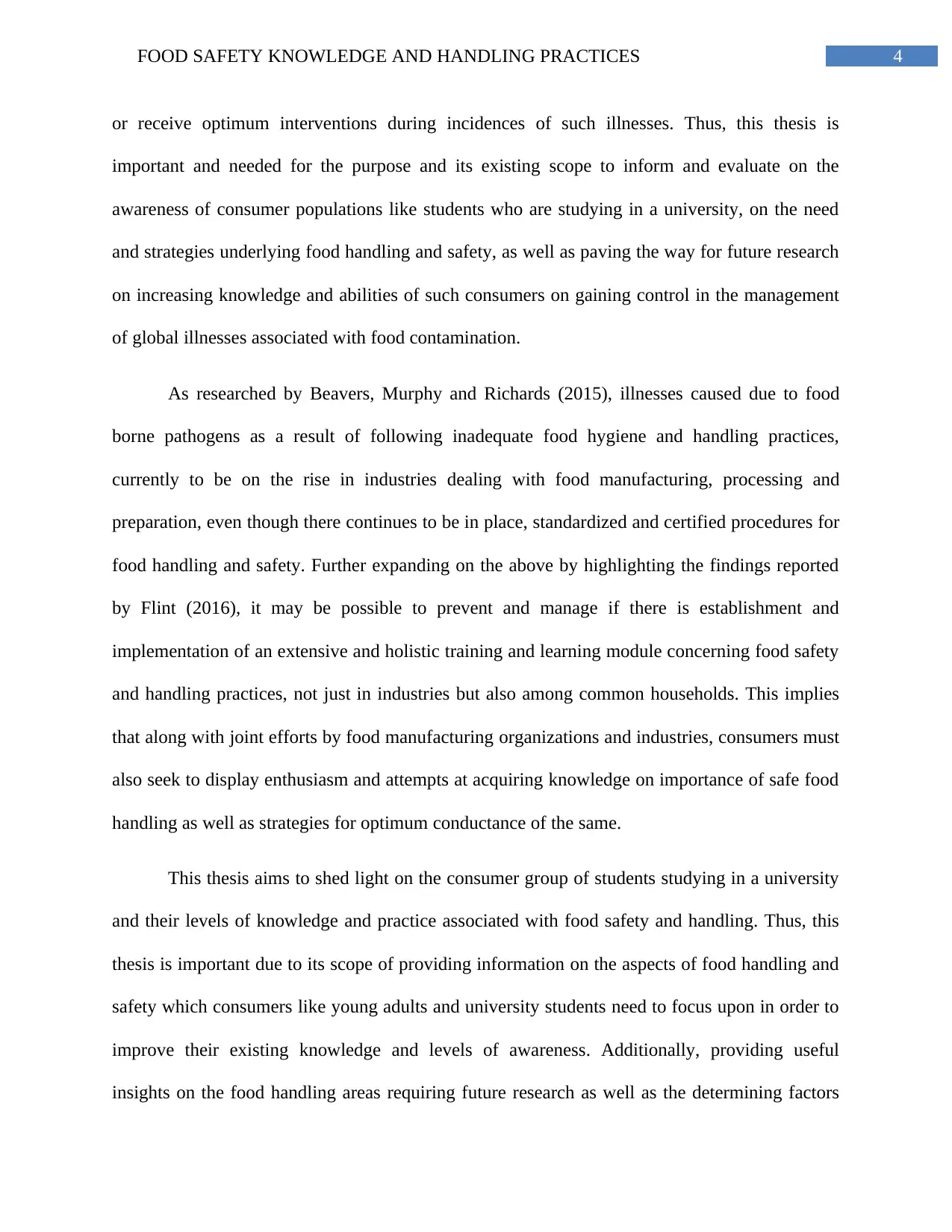
4FOOD SAFETY KNOWLEDGE AND HANDLING PRACTICES
or receive optimum interventions during incidences of such illnesses. Thus, this thesis is
important and needed for the purpose and its existing scope to inform and evaluate on the
awareness of consumer populations like students who are studying in a university, on the need
and strategies underlying food handling and safety, as well as paving the way for future research
on increasing knowledge and abilities of such consumers on gaining control in the management
of global illnesses associated with food contamination.
As researched by Beavers, Murphy and Richards (2015), illnesses caused due to food
borne pathogens as a result of following inadequate food hygiene and handling practices,
currently to be on the rise in industries dealing with food manufacturing, processing and
preparation, even though there continues to be in place, standardized and certified procedures for
food handling and safety. Further expanding on the above by highlighting the findings reported
by Flint (2016), it may be possible to prevent and manage if there is establishment and
implementation of an extensive and holistic training and learning module concerning food safety
and handling practices, not just in industries but also among common households. This implies
that along with joint efforts by food manufacturing organizations and industries, consumers must
also seek to display enthusiasm and attempts at acquiring knowledge on importance of safe food
handling as well as strategies for optimum conductance of the same.
This thesis aims to shed light on the consumer group of students studying in a university
and their levels of knowledge and practice associated with food safety and handling. Thus, this
thesis is important due to its scope of providing information on the aspects of food handling and
safety which consumers like young adults and university students need to focus upon in order to
improve their existing knowledge and levels of awareness. Additionally, providing useful
insights on the food handling areas requiring future research as well as the determining factors
or receive optimum interventions during incidences of such illnesses. Thus, this thesis is
important and needed for the purpose and its existing scope to inform and evaluate on the
awareness of consumer populations like students who are studying in a university, on the need
and strategies underlying food handling and safety, as well as paving the way for future research
on increasing knowledge and abilities of such consumers on gaining control in the management
of global illnesses associated with food contamination.
As researched by Beavers, Murphy and Richards (2015), illnesses caused due to food
borne pathogens as a result of following inadequate food hygiene and handling practices,
currently to be on the rise in industries dealing with food manufacturing, processing and
preparation, even though there continues to be in place, standardized and certified procedures for
food handling and safety. Further expanding on the above by highlighting the findings reported
by Flint (2016), it may be possible to prevent and manage if there is establishment and
implementation of an extensive and holistic training and learning module concerning food safety
and handling practices, not just in industries but also among common households. This implies
that along with joint efforts by food manufacturing organizations and industries, consumers must
also seek to display enthusiasm and attempts at acquiring knowledge on importance of safe food
handling as well as strategies for optimum conductance of the same.
This thesis aims to shed light on the consumer group of students studying in a university
and their levels of knowledge and practice associated with food safety and handling. Thus, this
thesis is important due to its scope of providing information on the aspects of food handling and
safety which consumers like young adults and university students need to focus upon in order to
improve their existing knowledge and levels of awareness. Additionally, providing useful
insights on the food handling areas requiring future research as well as the determining factors
Paraphrase This Document
Need a fresh take? Get an instant paraphrase of this document with our AI Paraphraser
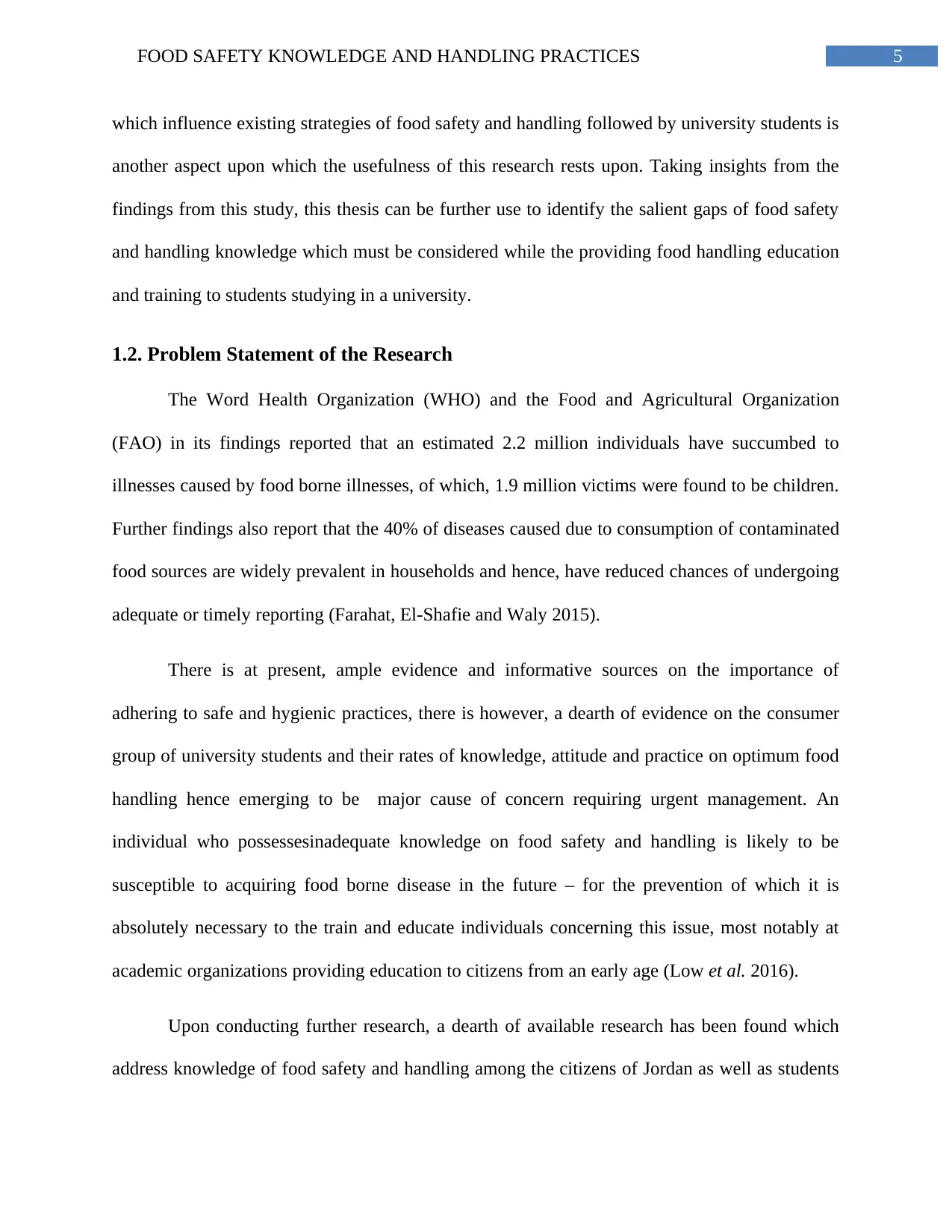
5FOOD SAFETY KNOWLEDGE AND HANDLING PRACTICES
which influence existing strategies of food safety and handling followed by university students is
another aspect upon which the usefulness of this research rests upon. Taking insights from the
findings from this study, this thesis can be further use to identify the salient gaps of food safety
and handling knowledge which must be considered while the providing food handling education
and training to students studying in a university.
1.2. Problem Statement of the Research
The Word Health Organization (WHO) and the Food and Agricultural Organization
(FAO) in its findings reported that an estimated 2.2 million individuals have succumbed to
illnesses caused by food borne illnesses, of which, 1.9 million victims were found to be children.
Further findings also report that the 40% of diseases caused due to consumption of contaminated
food sources are widely prevalent in households and hence, have reduced chances of undergoing
adequate or timely reporting (Farahat, El-Shafie and Waly 2015).
There is at present, ample evidence and informative sources on the importance of
adhering to safe and hygienic practices, there is however, a dearth of evidence on the consumer
group of university students and their rates of knowledge, attitude and practice on optimum food
handling hence emerging to be major cause of concern requiring urgent management. An
individual who possessesinadequate knowledge on food safety and handling is likely to be
susceptible to acquiring food borne disease in the future – for the prevention of which it is
absolutely necessary to the train and educate individuals concerning this issue, most notably at
academic organizations providing education to citizens from an early age (Low et al. 2016).
Upon conducting further research, a dearth of available research has been found which
address knowledge of food safety and handling among the citizens of Jordan as well as students
which influence existing strategies of food safety and handling followed by university students is
another aspect upon which the usefulness of this research rests upon. Taking insights from the
findings from this study, this thesis can be further use to identify the salient gaps of food safety
and handling knowledge which must be considered while the providing food handling education
and training to students studying in a university.
1.2. Problem Statement of the Research
The Word Health Organization (WHO) and the Food and Agricultural Organization
(FAO) in its findings reported that an estimated 2.2 million individuals have succumbed to
illnesses caused by food borne illnesses, of which, 1.9 million victims were found to be children.
Further findings also report that the 40% of diseases caused due to consumption of contaminated
food sources are widely prevalent in households and hence, have reduced chances of undergoing
adequate or timely reporting (Farahat, El-Shafie and Waly 2015).
There is at present, ample evidence and informative sources on the importance of
adhering to safe and hygienic practices, there is however, a dearth of evidence on the consumer
group of university students and their rates of knowledge, attitude and practice on optimum food
handling hence emerging to be major cause of concern requiring urgent management. An
individual who possessesinadequate knowledge on food safety and handling is likely to be
susceptible to acquiring food borne disease in the future – for the prevention of which it is
absolutely necessary to the train and educate individuals concerning this issue, most notably at
academic organizations providing education to citizens from an early age (Low et al. 2016).
Upon conducting further research, a dearth of available research has been found which
address knowledge of food safety and handling among the citizens of Jordan as well as students
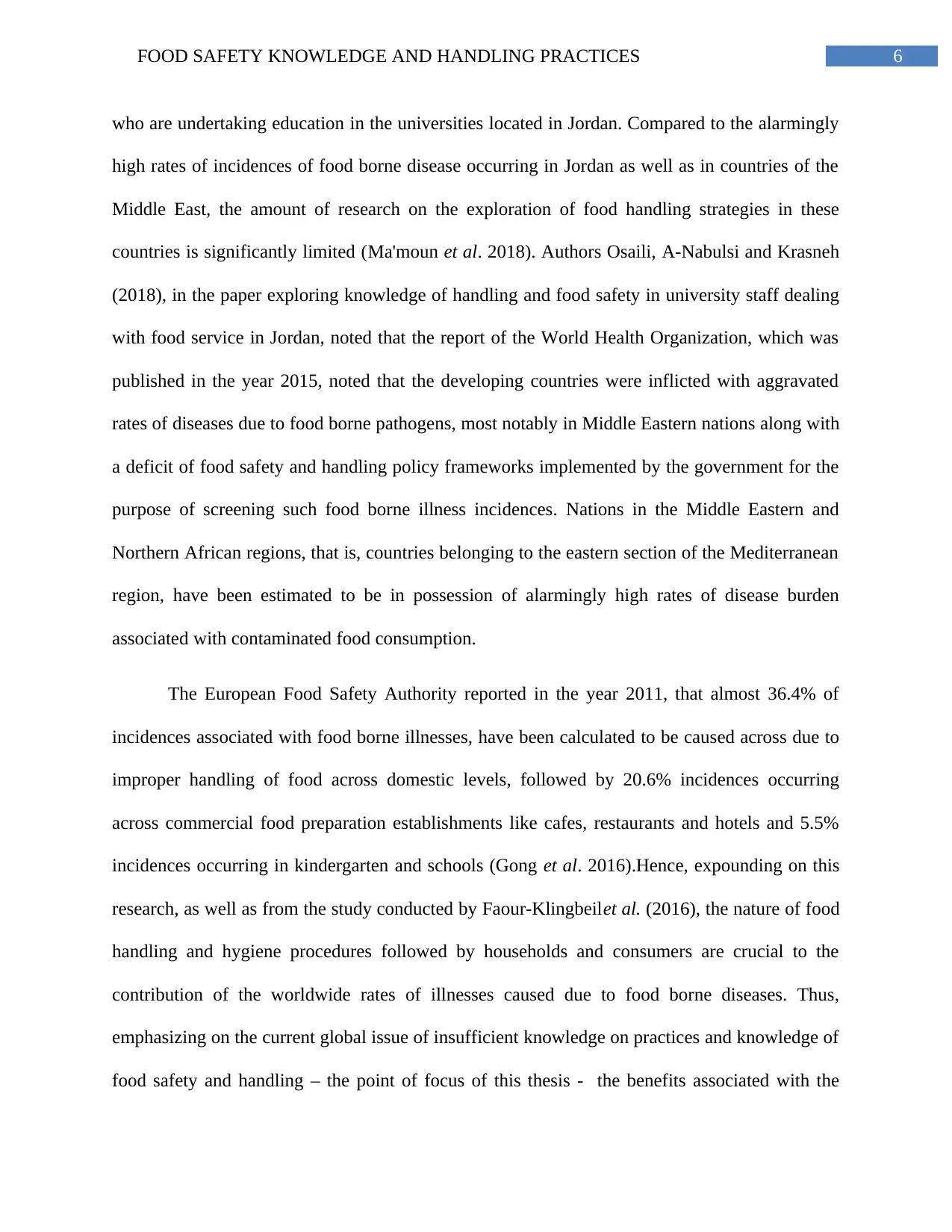
6FOOD SAFETY KNOWLEDGE AND HANDLING PRACTICES
who are undertaking education in the universities located in Jordan. Compared to the alarmingly
high rates of incidences of food borne disease occurring in Jordan as well as in countries of the
Middle East, the amount of research on the exploration of food handling strategies in these
countries is significantly limited (Ma'moun et al. 2018). Authors Osaili, A-Nabulsi and Krasneh
(2018), in the paper exploring knowledge of handling and food safety in university staff dealing
with food service in Jordan, noted that the report of the World Health Organization, which was
published in the year 2015, noted that the developing countries were inflicted with aggravated
rates of diseases due to food borne pathogens, most notably in Middle Eastern nations along with
a deficit of food safety and handling policy frameworks implemented by the government for the
purpose of screening such food borne illness incidences. Nations in the Middle Eastern and
Northern African regions, that is, countries belonging to the eastern section of the Mediterranean
region, have been estimated to be in possession of alarmingly high rates of disease burden
associated with contaminated food consumption.
The European Food Safety Authority reported in the year 2011, that almost 36.4% of
incidences associated with food borne illnesses, have been calculated to be caused across due to
improper handling of food across domestic levels, followed by 20.6% incidences occurring
across commercial food preparation establishments like cafes, restaurants and hotels and 5.5%
incidences occurring in kindergarten and schools (Gong et al. 2016).Hence, expounding on this
research, as well as from the study conducted by Faour-Klingbeilet al. (2016), the nature of food
handling and hygiene procedures followed by households and consumers are crucial to the
contribution of the worldwide rates of illnesses caused due to food borne diseases. Thus,
emphasizing on the current global issue of insufficient knowledge on practices and knowledge of
food safety and handling – the point of focus of this thesis - the benefits associated with the
who are undertaking education in the universities located in Jordan. Compared to the alarmingly
high rates of incidences of food borne disease occurring in Jordan as well as in countries of the
Middle East, the amount of research on the exploration of food handling strategies in these
countries is significantly limited (Ma'moun et al. 2018). Authors Osaili, A-Nabulsi and Krasneh
(2018), in the paper exploring knowledge of handling and food safety in university staff dealing
with food service in Jordan, noted that the report of the World Health Organization, which was
published in the year 2015, noted that the developing countries were inflicted with aggravated
rates of diseases due to food borne pathogens, most notably in Middle Eastern nations along with
a deficit of food safety and handling policy frameworks implemented by the government for the
purpose of screening such food borne illness incidences. Nations in the Middle Eastern and
Northern African regions, that is, countries belonging to the eastern section of the Mediterranean
region, have been estimated to be in possession of alarmingly high rates of disease burden
associated with contaminated food consumption.
The European Food Safety Authority reported in the year 2011, that almost 36.4% of
incidences associated with food borne illnesses, have been calculated to be caused across due to
improper handling of food across domestic levels, followed by 20.6% incidences occurring
across commercial food preparation establishments like cafes, restaurants and hotels and 5.5%
incidences occurring in kindergarten and schools (Gong et al. 2016).Hence, expounding on this
research, as well as from the study conducted by Faour-Klingbeilet al. (2016), the nature of food
handling and hygiene procedures followed by households and consumers are crucial to the
contribution of the worldwide rates of illnesses caused due to food borne diseases. Thus,
emphasizing on the current global issue of insufficient knowledge on practices and knowledge of
food safety and handling – the point of focus of this thesis - the benefits associated with the
⊘ This is a preview!⊘
Do you want full access?
Subscribe today to unlock all pages.

Trusted by 1+ million students worldwide
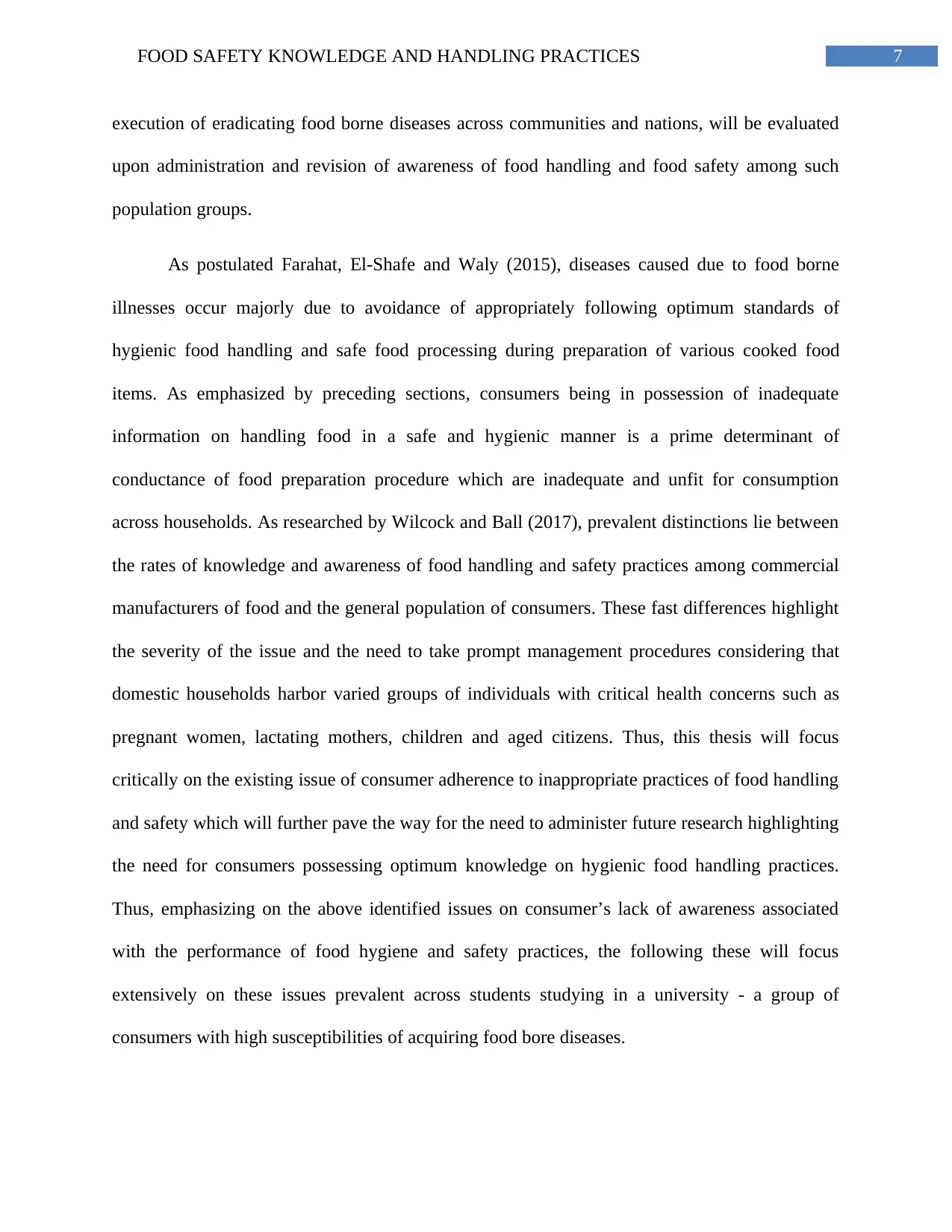
7FOOD SAFETY KNOWLEDGE AND HANDLING PRACTICES
execution of eradicating food borne diseases across communities and nations, will be evaluated
upon administration and revision of awareness of food handling and food safety among such
population groups.
As postulated Farahat, El-Shafe and Waly (2015), diseases caused due to food borne
illnesses occur majorly due to avoidance of appropriately following optimum standards of
hygienic food handling and safe food processing during preparation of various cooked food
items. As emphasized by preceding sections, consumers being in possession of inadequate
information on handling food in a safe and hygienic manner is a prime determinant of
conductance of food preparation procedure which are inadequate and unfit for consumption
across households. As researched by Wilcock and Ball (2017), prevalent distinctions lie between
the rates of knowledge and awareness of food handling and safety practices among commercial
manufacturers of food and the general population of consumers. These fast differences highlight
the severity of the issue and the need to take prompt management procedures considering that
domestic households harbor varied groups of individuals with critical health concerns such as
pregnant women, lactating mothers, children and aged citizens. Thus, this thesis will focus
critically on the existing issue of consumer adherence to inappropriate practices of food handling
and safety which will further pave the way for the need to administer future research highlighting
the need for consumers possessing optimum knowledge on hygienic food handling practices.
Thus, emphasizing on the above identified issues on consumer’s lack of awareness associated
with the performance of food hygiene and safety practices, the following these will focus
extensively on these issues prevalent across students studying in a university - a group of
consumers with high susceptibilities of acquiring food bore diseases.
execution of eradicating food borne diseases across communities and nations, will be evaluated
upon administration and revision of awareness of food handling and food safety among such
population groups.
As postulated Farahat, El-Shafe and Waly (2015), diseases caused due to food borne
illnesses occur majorly due to avoidance of appropriately following optimum standards of
hygienic food handling and safe food processing during preparation of various cooked food
items. As emphasized by preceding sections, consumers being in possession of inadequate
information on handling food in a safe and hygienic manner is a prime determinant of
conductance of food preparation procedure which are inadequate and unfit for consumption
across households. As researched by Wilcock and Ball (2017), prevalent distinctions lie between
the rates of knowledge and awareness of food handling and safety practices among commercial
manufacturers of food and the general population of consumers. These fast differences highlight
the severity of the issue and the need to take prompt management procedures considering that
domestic households harbor varied groups of individuals with critical health concerns such as
pregnant women, lactating mothers, children and aged citizens. Thus, this thesis will focus
critically on the existing issue of consumer adherence to inappropriate practices of food handling
and safety which will further pave the way for the need to administer future research highlighting
the need for consumers possessing optimum knowledge on hygienic food handling practices.
Thus, emphasizing on the above identified issues on consumer’s lack of awareness associated
with the performance of food hygiene and safety practices, the following these will focus
extensively on these issues prevalent across students studying in a university - a group of
consumers with high susceptibilities of acquiring food bore diseases.
Paraphrase This Document
Need a fresh take? Get an instant paraphrase of this document with our AI Paraphraser
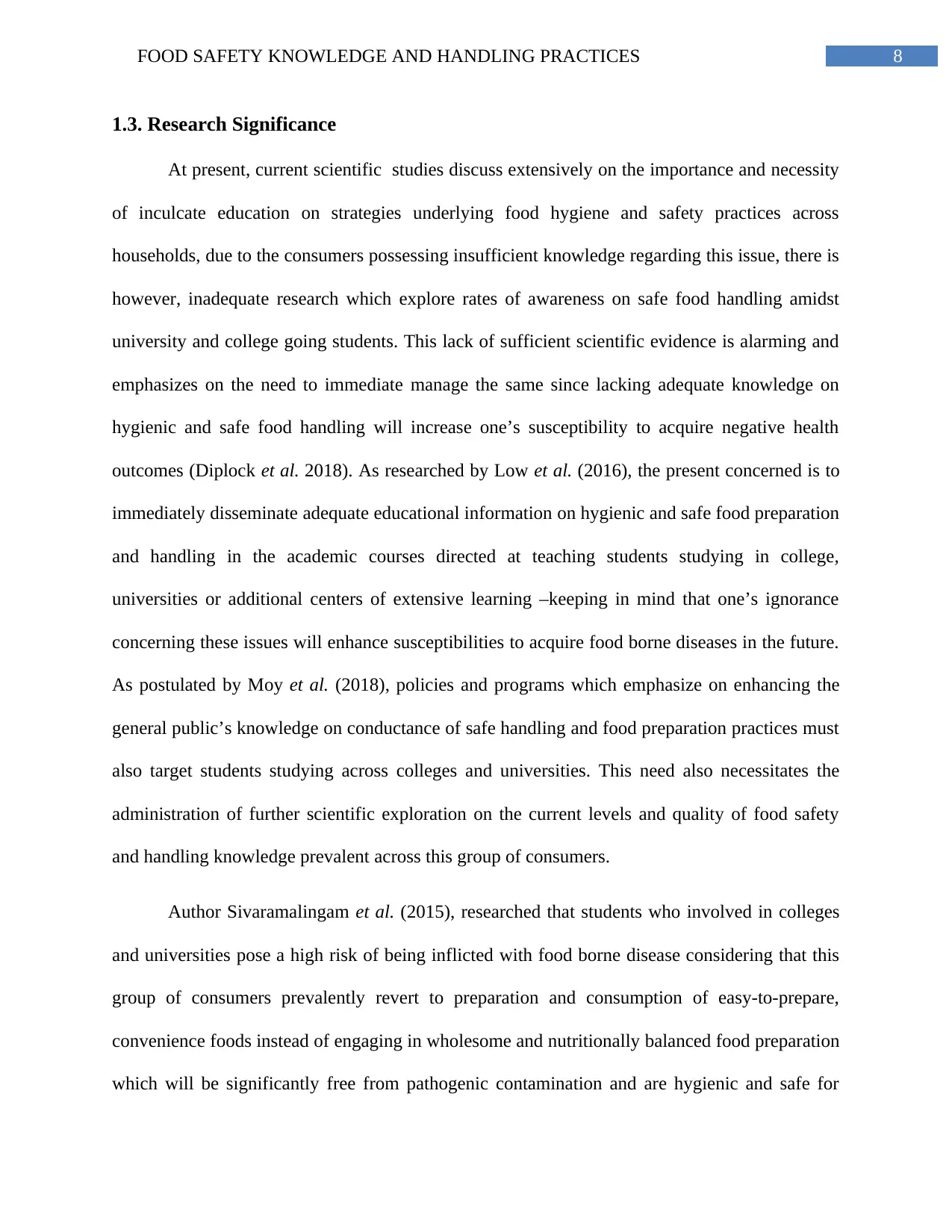
8FOOD SAFETY KNOWLEDGE AND HANDLING PRACTICES
1.3. Research Significance
At present, current scientific studies discuss extensively on the importance and necessity
of inculcate education on strategies underlying food hygiene and safety practices across
households, due to the consumers possessing insufficient knowledge regarding this issue, there is
however, inadequate research which explore rates of awareness on safe food handling amidst
university and college going students. This lack of sufficient scientific evidence is alarming and
emphasizes on the need to immediate manage the same since lacking adequate knowledge on
hygienic and safe food handling will increase one’s susceptibility to acquire negative health
outcomes (Diplock et al. 2018). As researched by Low et al. (2016), the present concerned is to
immediately disseminate adequate educational information on hygienic and safe food preparation
and handling in the academic courses directed at teaching students studying in college,
universities or additional centers of extensive learning –keeping in mind that one’s ignorance
concerning these issues will enhance susceptibilities to acquire food borne diseases in the future.
As postulated by Moy et al. (2018), policies and programs which emphasize on enhancing the
general public’s knowledge on conductance of safe handling and food preparation practices must
also target students studying across colleges and universities. This need also necessitates the
administration of further scientific exploration on the current levels and quality of food safety
and handling knowledge prevalent across this group of consumers.
Author Sivaramalingam et al. (2015), researched that students who involved in colleges
and universities pose a high risk of being inflicted with food borne disease considering that this
group of consumers prevalently revert to preparation and consumption of easy-to-prepare,
convenience foods instead of engaging in wholesome and nutritionally balanced food preparation
which will be significantly free from pathogenic contamination and are hygienic and safe for
1.3. Research Significance
At present, current scientific studies discuss extensively on the importance and necessity
of inculcate education on strategies underlying food hygiene and safety practices across
households, due to the consumers possessing insufficient knowledge regarding this issue, there is
however, inadequate research which explore rates of awareness on safe food handling amidst
university and college going students. This lack of sufficient scientific evidence is alarming and
emphasizes on the need to immediate manage the same since lacking adequate knowledge on
hygienic and safe food handling will increase one’s susceptibility to acquire negative health
outcomes (Diplock et al. 2018). As researched by Low et al. (2016), the present concerned is to
immediately disseminate adequate educational information on hygienic and safe food preparation
and handling in the academic courses directed at teaching students studying in college,
universities or additional centers of extensive learning –keeping in mind that one’s ignorance
concerning these issues will enhance susceptibilities to acquire food borne diseases in the future.
As postulated by Moy et al. (2018), policies and programs which emphasize on enhancing the
general public’s knowledge on conductance of safe handling and food preparation practices must
also target students studying across colleges and universities. This need also necessitates the
administration of further scientific exploration on the current levels and quality of food safety
and handling knowledge prevalent across this group of consumers.
Author Sivaramalingam et al. (2015), researched that students who involved in colleges
and universities pose a high risk of being inflicted with food borne disease considering that this
group of consumers prevalently revert to preparation and consumption of easy-to-prepare,
convenience foods instead of engaging in wholesome and nutritionally balanced food preparation
which will be significantly free from pathogenic contamination and are hygienic and safe for
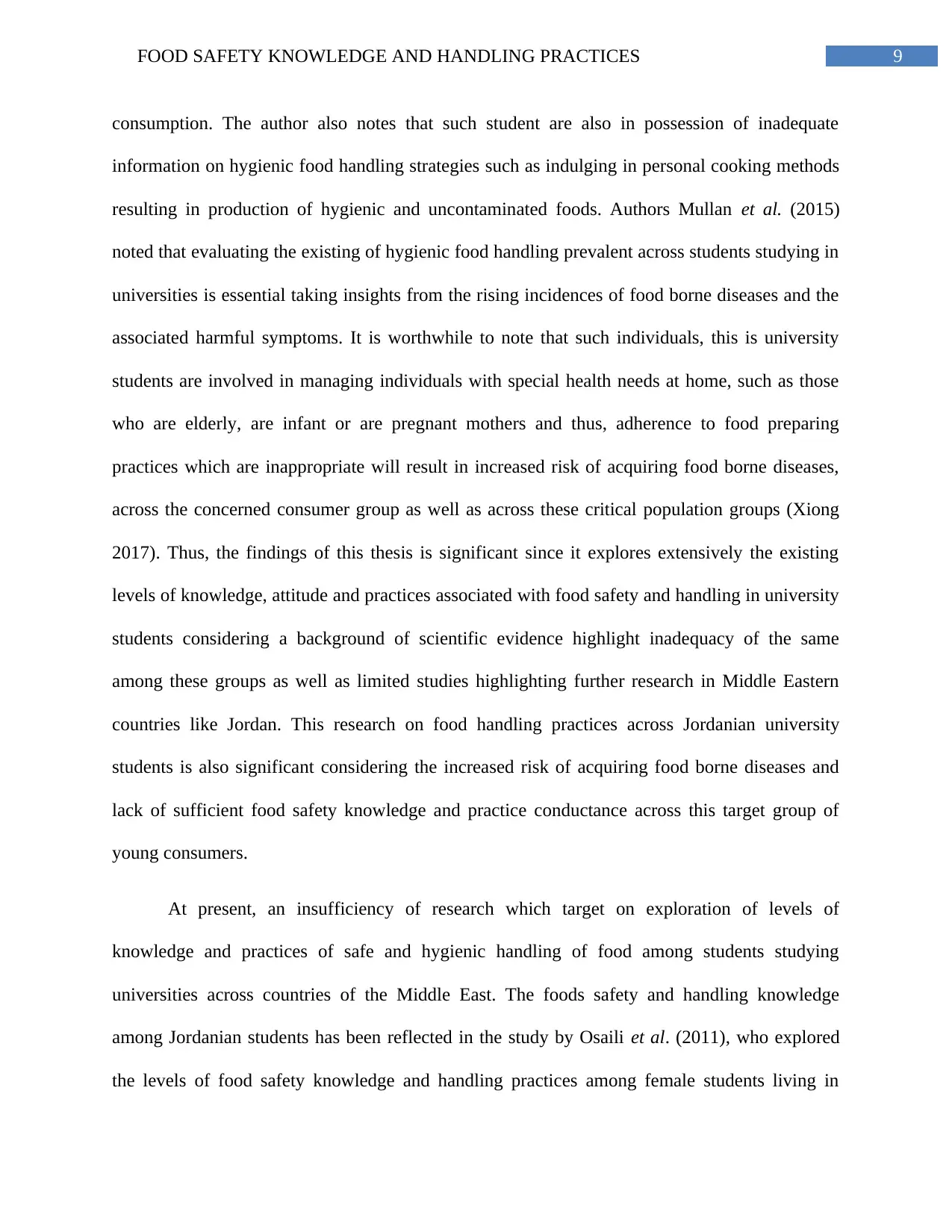
9FOOD SAFETY KNOWLEDGE AND HANDLING PRACTICES
consumption. The author also notes that such student are also in possession of inadequate
information on hygienic food handling strategies such as indulging in personal cooking methods
resulting in production of hygienic and uncontaminated foods. Authors Mullan et al. (2015)
noted that evaluating the existing of hygienic food handling prevalent across students studying in
universities is essential taking insights from the rising incidences of food borne diseases and the
associated harmful symptoms. It is worthwhile to note that such individuals, this is university
students are involved in managing individuals with special health needs at home, such as those
who are elderly, are infant or are pregnant mothers and thus, adherence to food preparing
practices which are inappropriate will result in increased risk of acquiring food borne diseases,
across the concerned consumer group as well as across these critical population groups (Xiong
2017). Thus, the findings of this thesis is significant since it explores extensively the existing
levels of knowledge, attitude and practices associated with food safety and handling in university
students considering a background of scientific evidence highlight inadequacy of the same
among these groups as well as limited studies highlighting further research in Middle Eastern
countries like Jordan. This research on food handling practices across Jordanian university
students is also significant considering the increased risk of acquiring food borne diseases and
lack of sufficient food safety knowledge and practice conductance across this target group of
young consumers.
At present, an insufficiency of research which target on exploration of levels of
knowledge and practices of safe and hygienic handling of food among students studying
universities across countries of the Middle East. The foods safety and handling knowledge
among Jordanian students has been reflected in the study by Osaili et al. (2011), who explored
the levels of food safety knowledge and handling practices among female students living in
consumption. The author also notes that such student are also in possession of inadequate
information on hygienic food handling strategies such as indulging in personal cooking methods
resulting in production of hygienic and uncontaminated foods. Authors Mullan et al. (2015)
noted that evaluating the existing of hygienic food handling prevalent across students studying in
universities is essential taking insights from the rising incidences of food borne diseases and the
associated harmful symptoms. It is worthwhile to note that such individuals, this is university
students are involved in managing individuals with special health needs at home, such as those
who are elderly, are infant or are pregnant mothers and thus, adherence to food preparing
practices which are inappropriate will result in increased risk of acquiring food borne diseases,
across the concerned consumer group as well as across these critical population groups (Xiong
2017). Thus, the findings of this thesis is significant since it explores extensively the existing
levels of knowledge, attitude and practices associated with food safety and handling in university
students considering a background of scientific evidence highlight inadequacy of the same
among these groups as well as limited studies highlighting further research in Middle Eastern
countries like Jordan. This research on food handling practices across Jordanian university
students is also significant considering the increased risk of acquiring food borne diseases and
lack of sufficient food safety knowledge and practice conductance across this target group of
young consumers.
At present, an insufficiency of research which target on exploration of levels of
knowledge and practices of safe and hygienic handling of food among students studying
universities across countries of the Middle East. The foods safety and handling knowledge
among Jordanian students has been reflected in the study by Osaili et al. (2011), who explored
the levels of food safety knowledge and handling practices among female students living in
⊘ This is a preview!⊘
Do you want full access?
Subscribe today to unlock all pages.

Trusted by 1+ million students worldwide
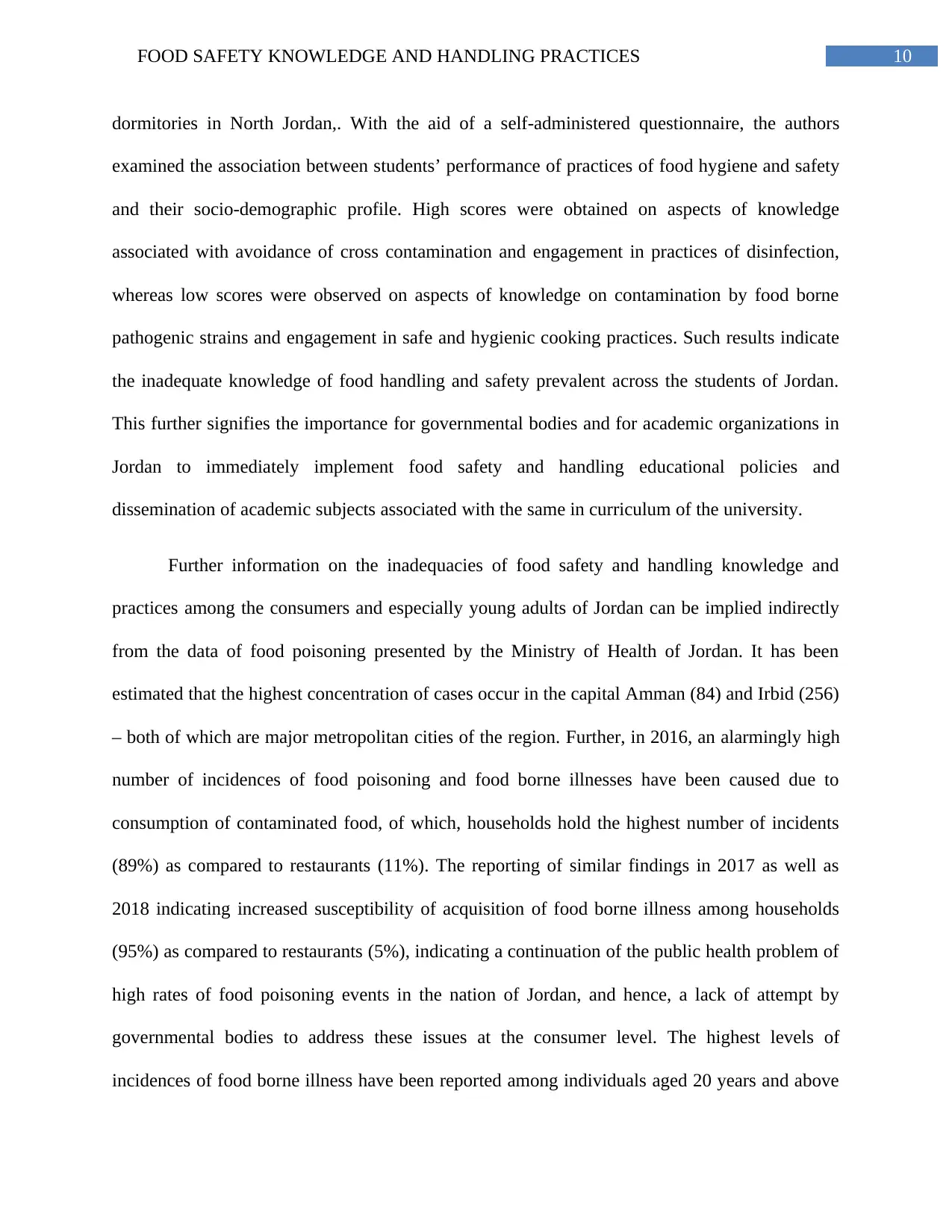
10FOOD SAFETY KNOWLEDGE AND HANDLING PRACTICES
dormitories in North Jordan,. With the aid of a self-administered questionnaire, the authors
examined the association between students’ performance of practices of food hygiene and safety
and their socio-demographic profile. High scores were obtained on aspects of knowledge
associated with avoidance of cross contamination and engagement in practices of disinfection,
whereas low scores were observed on aspects of knowledge on contamination by food borne
pathogenic strains and engagement in safe and hygienic cooking practices. Such results indicate
the inadequate knowledge of food handling and safety prevalent across the students of Jordan.
This further signifies the importance for governmental bodies and for academic organizations in
Jordan to immediately implement food safety and handling educational policies and
dissemination of academic subjects associated with the same in curriculum of the university.
Further information on the inadequacies of food safety and handling knowledge and
practices among the consumers and especially young adults of Jordan can be implied indirectly
from the data of food poisoning presented by the Ministry of Health of Jordan. It has been
estimated that the highest concentration of cases occur in the capital Amman (84) and Irbid (256)
– both of which are major metropolitan cities of the region. Further, in 2016, an alarmingly high
number of incidences of food poisoning and food borne illnesses have been caused due to
consumption of contaminated food, of which, households hold the highest number of incidents
(89%) as compared to restaurants (11%). The reporting of similar findings in 2017 as well as
2018 indicating increased susceptibility of acquisition of food borne illness among households
(95%) as compared to restaurants (5%), indicating a continuation of the public health problem of
high rates of food poisoning events in the nation of Jordan, and hence, a lack of attempt by
governmental bodies to address these issues at the consumer level. The highest levels of
incidences of food borne illness have been reported among individuals aged 20 years and above
dormitories in North Jordan,. With the aid of a self-administered questionnaire, the authors
examined the association between students’ performance of practices of food hygiene and safety
and their socio-demographic profile. High scores were obtained on aspects of knowledge
associated with avoidance of cross contamination and engagement in practices of disinfection,
whereas low scores were observed on aspects of knowledge on contamination by food borne
pathogenic strains and engagement in safe and hygienic cooking practices. Such results indicate
the inadequate knowledge of food handling and safety prevalent across the students of Jordan.
This further signifies the importance for governmental bodies and for academic organizations in
Jordan to immediately implement food safety and handling educational policies and
dissemination of academic subjects associated with the same in curriculum of the university.
Further information on the inadequacies of food safety and handling knowledge and
practices among the consumers and especially young adults of Jordan can be implied indirectly
from the data of food poisoning presented by the Ministry of Health of Jordan. It has been
estimated that the highest concentration of cases occur in the capital Amman (84) and Irbid (256)
– both of which are major metropolitan cities of the region. Further, in 2016, an alarmingly high
number of incidences of food poisoning and food borne illnesses have been caused due to
consumption of contaminated food, of which, households hold the highest number of incidents
(89%) as compared to restaurants (11%). The reporting of similar findings in 2017 as well as
2018 indicating increased susceptibility of acquisition of food borne illness among households
(95%) as compared to restaurants (5%), indicating a continuation of the public health problem of
high rates of food poisoning events in the nation of Jordan, and hence, a lack of attempt by
governmental bodies to address these issues at the consumer level. The highest levels of
incidences of food borne illness have been reported among individuals aged 20 years and above
Paraphrase This Document
Need a fresh take? Get an instant paraphrase of this document with our AI Paraphraser
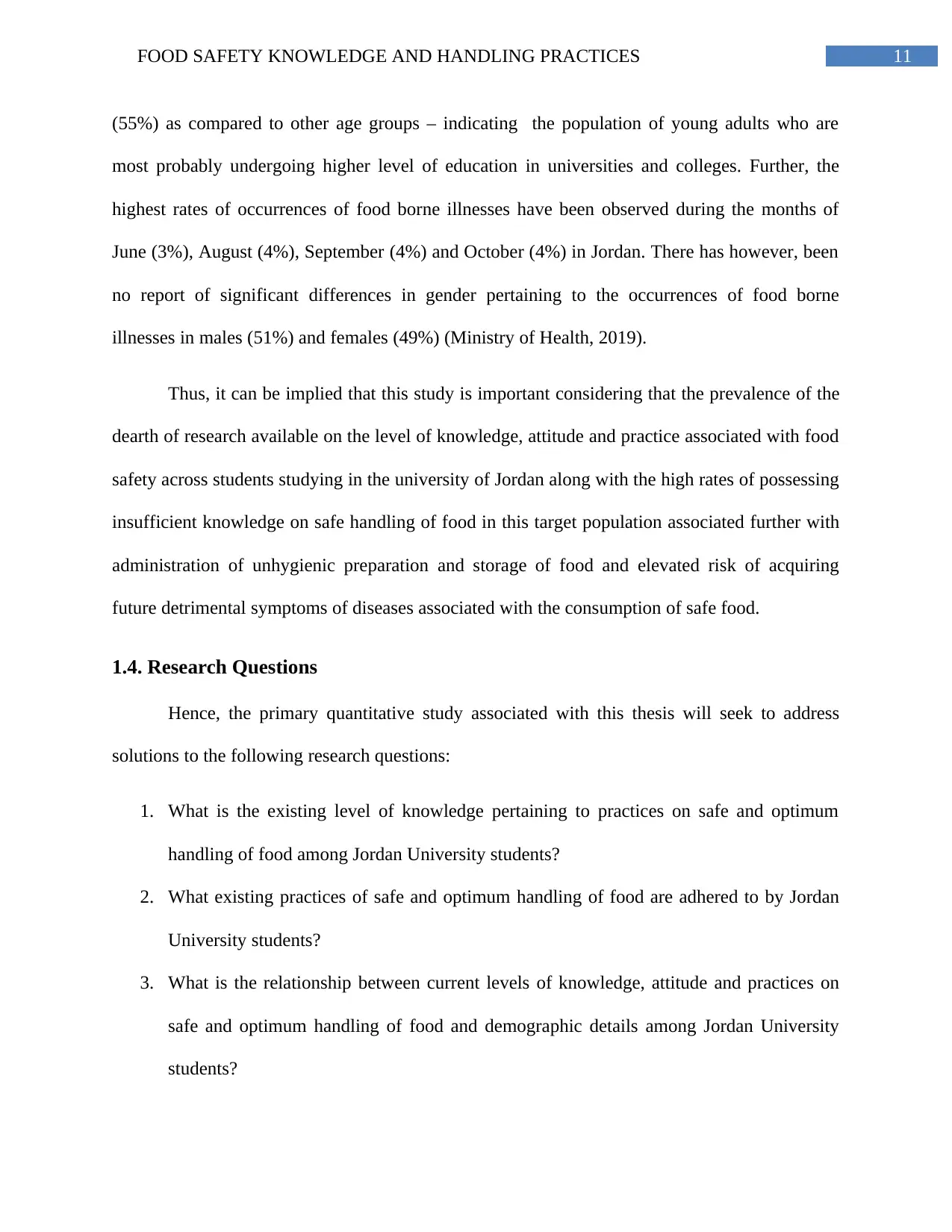
11FOOD SAFETY KNOWLEDGE AND HANDLING PRACTICES
(55%) as compared to other age groups – indicating the population of young adults who are
most probably undergoing higher level of education in universities and colleges. Further, the
highest rates of occurrences of food borne illnesses have been observed during the months of
June (3%), August (4%), September (4%) and October (4%) in Jordan. There has however, been
no report of significant differences in gender pertaining to the occurrences of food borne
illnesses in males (51%) and females (49%) (Ministry of Health, 2019).
Thus, it can be implied that this study is important considering that the prevalence of the
dearth of research available on the level of knowledge, attitude and practice associated with food
safety across students studying in the university of Jordan along with the high rates of possessing
insufficient knowledge on safe handling of food in this target population associated further with
administration of unhygienic preparation and storage of food and elevated risk of acquiring
future detrimental symptoms of diseases associated with the consumption of safe food.
1.4. Research Questions
Hence, the primary quantitative study associated with this thesis will seek to address
solutions to the following research questions:
1. What is the existing level of knowledge pertaining to practices on safe and optimum
handling of food among Jordan University students?
2. What existing practices of safe and optimum handling of food are adhered to by Jordan
University students?
3. What is the relationship between current levels of knowledge, attitude and practices on
safe and optimum handling of food and demographic details among Jordan University
students?
(55%) as compared to other age groups – indicating the population of young adults who are
most probably undergoing higher level of education in universities and colleges. Further, the
highest rates of occurrences of food borne illnesses have been observed during the months of
June (3%), August (4%), September (4%) and October (4%) in Jordan. There has however, been
no report of significant differences in gender pertaining to the occurrences of food borne
illnesses in males (51%) and females (49%) (Ministry of Health, 2019).
Thus, it can be implied that this study is important considering that the prevalence of the
dearth of research available on the level of knowledge, attitude and practice associated with food
safety across students studying in the university of Jordan along with the high rates of possessing
insufficient knowledge on safe handling of food in this target population associated further with
administration of unhygienic preparation and storage of food and elevated risk of acquiring
future detrimental symptoms of diseases associated with the consumption of safe food.
1.4. Research Questions
Hence, the primary quantitative study associated with this thesis will seek to address
solutions to the following research questions:
1. What is the existing level of knowledge pertaining to practices on safe and optimum
handling of food among Jordan University students?
2. What existing practices of safe and optimum handling of food are adhered to by Jordan
University students?
3. What is the relationship between current levels of knowledge, attitude and practices on
safe and optimum handling of food and demographic details among Jordan University
students?
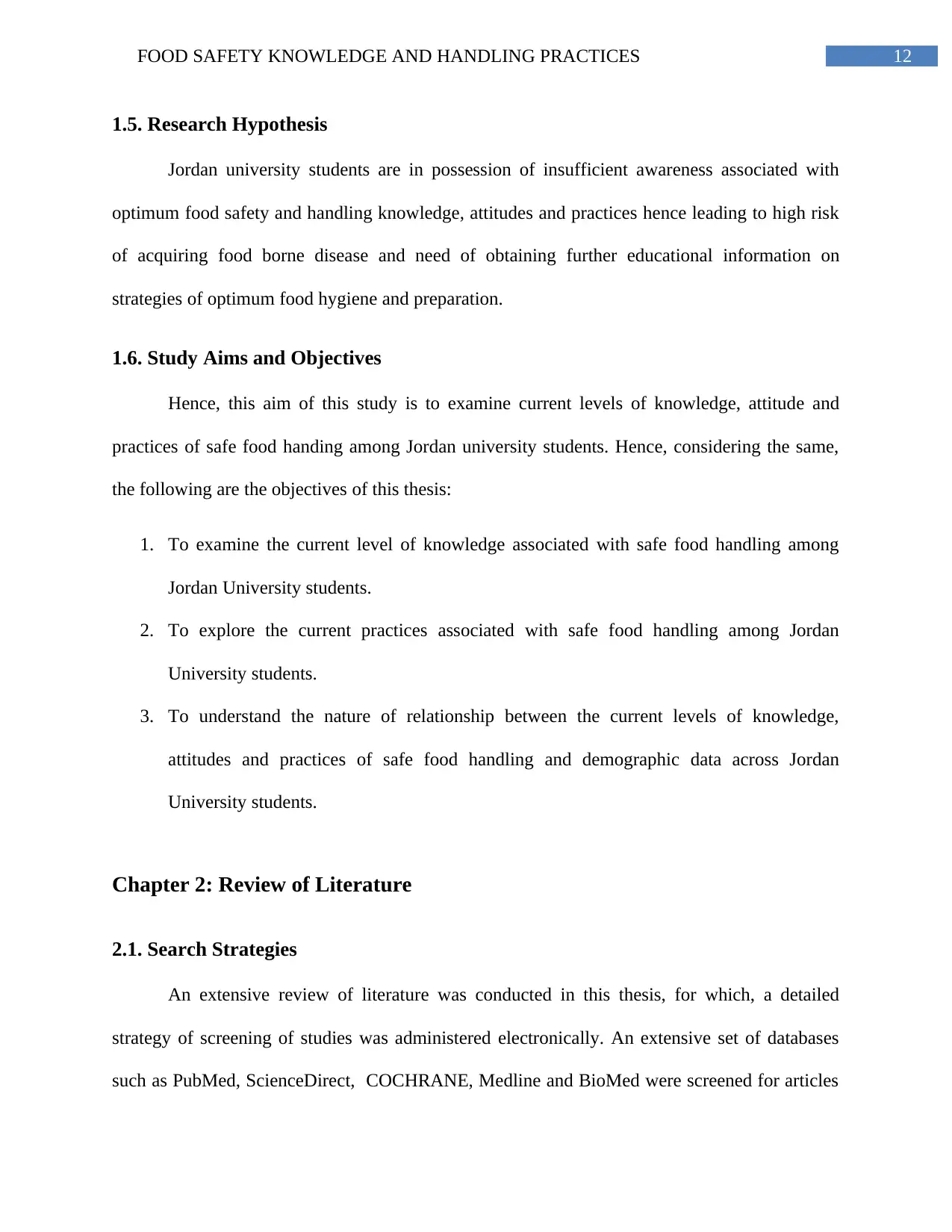
12FOOD SAFETY KNOWLEDGE AND HANDLING PRACTICES
1.5. Research Hypothesis
Jordan university students are in possession of insufficient awareness associated with
optimum food safety and handling knowledge, attitudes and practices hence leading to high risk
of acquiring food borne disease and need of obtaining further educational information on
strategies of optimum food hygiene and preparation.
1.6. Study Aims and Objectives
Hence, this aim of this study is to examine current levels of knowledge, attitude and
practices of safe food handing among Jordan university students. Hence, considering the same,
the following are the objectives of this thesis:
1. To examine the current level of knowledge associated with safe food handling among
Jordan University students.
2. To explore the current practices associated with safe food handling among Jordan
University students.
3. To understand the nature of relationship between the current levels of knowledge,
attitudes and practices of safe food handling and demographic data across Jordan
University students.
Chapter 2: Review of Literature
2.1. Search Strategies
An extensive review of literature was conducted in this thesis, for which, a detailed
strategy of screening of studies was administered electronically. An extensive set of databases
such as PubMed, ScienceDirect, COCHRANE, Medline and BioMed were screened for articles
1.5. Research Hypothesis
Jordan university students are in possession of insufficient awareness associated with
optimum food safety and handling knowledge, attitudes and practices hence leading to high risk
of acquiring food borne disease and need of obtaining further educational information on
strategies of optimum food hygiene and preparation.
1.6. Study Aims and Objectives
Hence, this aim of this study is to examine current levels of knowledge, attitude and
practices of safe food handing among Jordan university students. Hence, considering the same,
the following are the objectives of this thesis:
1. To examine the current level of knowledge associated with safe food handling among
Jordan University students.
2. To explore the current practices associated with safe food handling among Jordan
University students.
3. To understand the nature of relationship between the current levels of knowledge,
attitudes and practices of safe food handling and demographic data across Jordan
University students.
Chapter 2: Review of Literature
2.1. Search Strategies
An extensive review of literature was conducted in this thesis, for which, a detailed
strategy of screening of studies was administered electronically. An extensive set of databases
such as PubMed, ScienceDirect, COCHRANE, Medline and BioMed were screened for articles
⊘ This is a preview!⊘
Do you want full access?
Subscribe today to unlock all pages.

Trusted by 1+ million students worldwide
1 out of 86
Related Documents
Your All-in-One AI-Powered Toolkit for Academic Success.
+13062052269
info@desklib.com
Available 24*7 on WhatsApp / Email
![[object Object]](/_next/static/media/star-bottom.7253800d.svg)
Unlock your academic potential
Copyright © 2020–2025 A2Z Services. All Rights Reserved. Developed and managed by ZUCOL.





